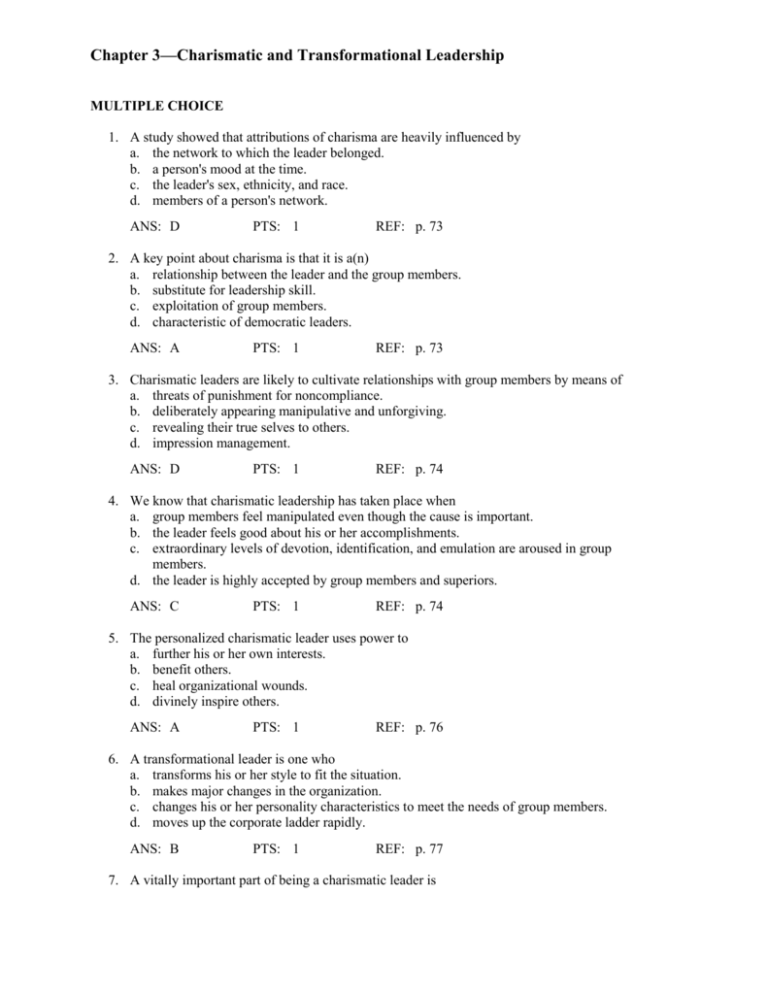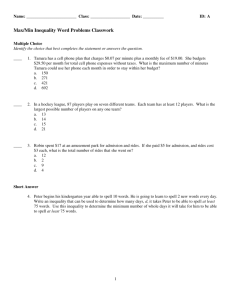PRACTICE QUIZ TWO Charismatic etc (chp 3)
advertisement

Chapter 3—Charismatic and Transformational Leadership MULTIPLE CHOICE 1. A study showed that attributions of charisma are heavily influenced by a. the network to which the leader belonged. b. a person's mood at the time. c. the leader's sex, ethnicity, and race. d. members of a person's network. ANS: D PTS: 1 REF: p. 73 2. A key point about charisma is that it is a(n) a. relationship between the leader and the group members. b. substitute for leadership skill. c. exploitation of group members. d. characteristic of democratic leaders. ANS: A PTS: 1 REF: p. 73 3. Charismatic leaders are likely to cultivate relationships with group members by means of a. threats of punishment for noncompliance. b. deliberately appearing manipulative and unforgiving. c. revealing their true selves to others. d. impression management. ANS: D PTS: 1 REF: p. 74 4. We know that charismatic leadership has taken place when a. group members feel manipulated even though the cause is important. b. the leader feels good about his or her accomplishments. c. extraordinary levels of devotion, identification, and emulation are aroused in group members. d. the leader is highly accepted by group members and superiors. ANS: C PTS: 1 REF: p. 74 5. The personalized charismatic leader uses power to a. further his or her own interests. b. benefit others. c. heal organizational wounds. d. divinely inspire others. ANS: A PTS: 1 REF: p. 76 6. A transformational leader is one who a. transforms his or her style to fit the situation. b. makes major changes in the organization. c. changes his or her personality characteristics to meet the needs of group members. d. moves up the corporate ladder rapidly. ANS: B PTS: 1 REF: p. 77 7. A vitally important part of being a charismatic leader is a. b. c. d. asking group members perceptive questions. being emotionally expressive and warm. being laid back and emotionally supportive. having a large network of contacts. ANS: B PTS: 1 REF: p. 78 8. Charismatic leaders are characterized as a. having considerable internal conflict. b. creating distrust among constituents. c. minimizing risks. d. being willing to use unconventional strategies. ANS: D PTS: 1 REF: p. 78 9. A charismatic leader will often a. be low key about his or her accomplishments. b. be a low risk taker. c. procrastinate about major decisions. d. challenge, prod, and poke other people. ANS: D PTS: 1 REF: p. 80 10. A vision deals mostly with a. a forecast of future business conditions. b. seeing clearly what needs to be done to fix organizational problems. c. the ability to imagine different and better conditions and the ways to achieve them. d. finding creative ways to reward organizational members. ANS: C PTS: 1 REF: p. 80 11. Brain research about visions suggests that visionaries in contrast to non-visionaries, a. have different levels of brain activity. b. are less intelligent. c. have less capacity for visual processing. d. show less brain activity. ANS: A PTS: 1 REF: p. 81 12. Which of the following would most likely be a vision for Avon Products? a. Get more men to purchase our products. b. Become the ultimate relationship marketer of products and services for women. c. Increase sales to underdeveloped countries by 5 percent per year. d. Develop five new products per year. ANS: B PTS: 1 REF: p. 81 13. Charismatic leaders use visions for the important purpose of a. keeping team members in line. b. conducting transactions with people. c. celebrating accomplishments. d. inspiring group members. ANS: D PTS: 1 REF: p. 81 14. Which one of the following is not particularly recommended as a method of formulating a vision? a. b. c. d. Searching out vision statements formulated by others Gathering input on what might delight group members Studying historical precedents Using your intuition about developments in your field ANS: C PTS: 1 REF: p. 82 15. To apply "management by storytelling," the leader should a. tell stories about unsuccessful competitors. b. tell fascinating stories about the company to employees. c. reward and punish group members based on anecdotal evidence. d. evaluate morale based on anecdotal evidence. ANS: B PTS: 1 REF: p. 84 16. Charismatic leaders use metaphors and analogies primarily to a. convince group members that they are confident. b. inspire team members. c. craft an articulate and highly emotional message. d. gear language to different audiences. ANS: B PTS: 1 REF: p. 83 17. A leader who is personally charismatic is likely to a. attract people to him or her. b. push away other people based on annoying personal characteristics. c. rule with an iron hand. d. rely on cognitive skills to impress people. ANS: A PTS: 1 REF: p. 76 18. An effective vision should a. replace the company goal-setting system. b. focus on day-to-day responsibilities instead of the future. c. fulfill the dreams of the leader. d. connect with the goals and dreams of constituents. ANS: D PTS: 1 REF: p. 87 19. Marcie is a charismatic leader. When she encounters Salvatore, a work associate she met once two years ago, Marcie is likely to say, a. "Hello Salvatore, good to see you again." b. "Hello there. It's nice to meet somebody new." c. "Hello, I vaguely recall us meeting before." d. "Hello there buddy. Could you give me your name again?" ANS: A PTS: 1 REF: p. 73 20. Max wants to develop a personal brand, so he a. develops a second identity on the Internet. b. attempts to wear as much clothing of the same brand as feasible. c. give himself a nick name such as "Corporate Warrior Max." d. studies his basket of personal strengths. ANS: D PTS: 1 REF: p. 88 21. A transactional leader in contrast to a transformational one is more likely to a. inspire group members with a compelling vision. b. help group members reach self-fulfillment. c. emphasize the growth of group members. d. emphasize rewards for good performance. ANS: D PTS: 1 REF: p. 89 22. One technique a leader uses to bring about transformations is to get people a. focused on minor satisfactions. b. not to worry that the organization's future is threatened. c. to accept early retirement, if appropriate. d. to look beyond self-interest. ANS: D PTS: 1 REF: p. 89 23. Melissa wants to bring about transformations in her organization. Which one of the following would be the best recommendation for her? a. Get people to develop a short-term perspective. b. Help people understand the need for change. c. Commit people to slightly better than average performance. d. Get people to think in terms of self-interest. ANS: B PTS: 1 REF: p. 92 24. A recommended strategy for a transformational leader attempting to help a troubled organization is to concentrate resources where a. good results will bring him or her the most publicity. b. change is needed the most and the potential payoff is big. c. subordinates will be surprised. d. promises have been broken in the past. ANS: B PTS: 1 REF: p. 93 25. Which one of the following is the least typical characteristic of a transformational leader? a. low standing on moral reasoning b. encouraging personal development of staff c. practicing empowerment d. charisma ANS: A PTS: 1 REF: p. 94 26. A synthesis of studies about transformational leadership and performance found that this type of leadership a. was positively associated with a group of criteria. b. was negatively associated with a group of criteria. c. was less effective than laissez-fire leadership. d. was good for performance but not satisfaction. ANS: A PTS: 1 REF: p. 99 27. A study of team leadership found that transformational leadership helped the group a. members work more independently. b. question whether their team had the "right stuff." c. feel more potent, leading to better performance. d. feel less potent, leading to poorer performance. ANS: C PTS: 1 REF: p. 95 28. The concept of leadership polarity suggests that group members a. tend to intensely like or dislike leaders. b. prefer opposite traits in the same leader. c. prefer leaders much like themselves. d. prefer leaders quite opposite to themselves. ANS: A PTS: 1 REF: p. 96 29. A challenge to the validity of charismatic leadership is that leaders might be a. coached to be charismatic. b. charismatic on the basis of inborn characteristics. c. relying too heavily on an autocratic style. d. perceived as charismatic because of their accomplishments. ANS: D PTS: 1 REF: p. 96 30. A major concern about charismatic leadership is that a. there are not enough job openings for all the charismatic leaders. b. charismatic leaders are not really so effective. c. group members sometimes follow a charismatic leader down an unethical path. d. charismatic leaders place unreasonable expectations on group members. ANS: C PTS: 1 REF: p. 97 TRUE/FALSE 31. A study showed that a person's perceptions of charisma tend to run in an opposite direction than those of his or her network members. ANS: F PTS: 1 REF: p. 73 32. Charismatic leaders are easy-going, natural people who tend to minimize impression management. ANS: F PTS: 1 REF: p. 74 33. One of the effects of charismatic leadership is the creation of a wide gap between the beliefs of the leader and those of group members. ANS: F PTS: 1 REF: p. 74 34. A statistical analysis of charismatic leadership revealed that charisma is composed of three factors: charm, assertiveness, and expert power. ANS: F PTS: 1 REF: p. 97 35. Being perceived as charismatic can often be important for a top-level leader to hold on to his or her position. ANS: T PTS: 1 REF: p. 75 36. A socialized charismatic leader is concerned primarily with using power for the good of other people. ANS: T PTS: 1 REF: p. 75 37. An essential part of being a charismatic and transformational leader is to offer constituents a vision of the future. ANS: T PTS: 1 REF: p. 87 38. Charismatic leaders are much more conservative than average with respect to risk taking. ANS: F PTS: 1 REF: p. 78 39. Part of a leader's vision is to implement the vision he or she created. ANS: T PTS: 1 REF: p. 81 40. A vision statement for AcerComputer is likely to be something to the effect, "Within three years we will increase our sales of desktop computers by 25 percent." ANS: F PTS: 1 REF: p. 81 41. Although they are confident people, charismatic leaders regularly solicit input from their constituents. ANS: T PTS: 1 REF: p. 83 42. To be truly effective for the purpose of charismatic leadership, a metaphor should appeal to the intellect, imagination, and values. ANS: T PTS: 1 REF: p. 83 43. Management by storytelling is a method used by charismatic and transformational leaders to discipline employees and involves telling them stories about what happened to other employees who stepped out of line. ANS: F PTS: 1 REF: p. 84 44. Brain research suggests that people who are perceived to be visionaries have much higher levels of activity in certain areas of the brain than do non-visionaries. ANS: T PTS: 1 REF: p. 81 45. An effective vision is aligned with the goals and dreams of group members. ANS: T PTS: 1 REF: p. 87 46. According to the leadership text, developing your energy level will help you become more charismatic. ANS: T PTS: 1 REF: p. 87 47. To develop your personal brand, it is recommended that you focus on patching up your weaknesses. ANS: F PTS: 1 REF: p. 88 48. Part of being charismatic is making an impressive physical appearance. ANS: T PTS: 1 REF: p. 88 49. Displaying an in-your-face attitude can contribute to a person's charisma. ANS: T PTS: 1 REF: p. 89 50. Because transformational leaders attempt to bring about change, they tend to focus on the short-range, as well as a narrow focus. ANS: F PTS: 1 REF: p. 89 51. To highly motivate organizational members, the transformational leader attempts to get constituents to focus on their self-interest. ANS: F PTS: 1 REF: p. 89 52. The effective transformational leader deliberately creates distrust throughout the organization so he or she will be needed to decrease the confusion. ANS: F PTS: 1 REF: p. 93 53. An effective strategy for a transformational leader is to concentrate resources on the areas most in need of change and with the biggest possible payoff. ANS: T PTS: 1 REF: p. 93 54. Despite the urgency of turning around an organization, the transformational leader is likely to encourage the personal development of staff members. ANS: T PTS: 1 REF: p. 94 55. Transformational leaders like to be in control, so they attempt to do most of the creative thinking for the group. ANS: F PTS: 1 REF: p. 94 56. Transformational leaders who are also charismatic will typically establish a vision for constituents to follow. ANS: T PTS: 1 REF: p. 87 57. A synthesis of studies showed that laissez-faire leadership is more likely to produce positive results for than the organization than will transformational leadership. ANS: F PTS: 1 REF: p. 89 58. A study indicated that transformational leadership of teams is likely to help the team feel more capable, and also perform better. ANS: T PTS: 1 REF: p. 98 59. A study of financial firms suggested that being charismatic tended to lower business unit performance because workers became distracted by the leader's charm. ANS: F PTS: 1 REF: p. 95 60. A recommended way of enhancing your charisma is to make others feel unimportant so you will appear strong in contrast. ANS: F PTS: 1 REF: p. 87







